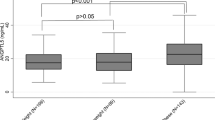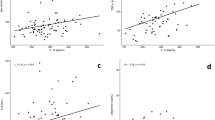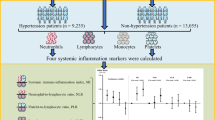Abstract
Background
Atherosclerosis is a chronic inflammatory disease that has its origins in childhood. The goal of this study was to explore the relationships of hematologic inflammatory markers to body mass, biochemical inflammatory markers and cardiometabolic risk factors.
Methods
Healthy, white, non-Hispanic identifying adolescents (n = 75, age 12 to 18 years) were enrolled. Measures studied included body mass index percentile (BMI%), neutrophil and platelet to lymphocyte ratio (NLR, PLR), pan immune inflammation value (PIV), lipids, augmentation index, reactive hyperemia, inflammatory markers (interleukin 6: IL6, c-reactive protein: CRP), complement (C3, C3a, C4, C4a, C5a) insulin secretion and insulin sensitivity (oral glucose tolerance test: Matusda index, and disposition index (DI)).
Results
NLR (rS = 0.31, p < 0.01), PLR (rS = 0.32, p < 0.01), PIV (rS = 0.32, p < 0.01) and CRP (rS = 0.51, p < 0.001) all positively correlated with BMI% but IL-6 did not. NLR, PLR and PIV all positively correlated with each other. NLR correlated with the reactive hyperemia response (rS = 0.29, p < 0.02) but this relationship was lost when BMI% was included. NLR positively correlated with C3a, C4, CRP and IL6 even when BMI% was included.
Conclusion
In healthy adolescents hematologic markers of inflammation increase with increasing body mass and neutrocyte to lymphocyte ratio is associated with increased complement and inflammatory markers independent of obesity.
Impact statement
-
Hematologic and biochemical markers of inflammation increase with increased body mass in healthy adolescents.
-
Hematologic and biochemical markers of inflammation are positively related independent of body mass in healthy adolescents.
-
Hematologic inflammatory markers are not related to markers of cardiometabolic risk in healthy adolescents.
This is a preview of subscription content, access via your institution
Access options
Subscribe to this journal
Receive 14 print issues and online access
$259.00 per year
only $18.50 per issue
Buy this article
- Purchase on Springer Link
- Instant access to full article PDF
Prices may be subject to local taxes which are calculated during checkout

Similar content being viewed by others
Data availability
The datasets generated during and/or analysed during the current study are available from the corresponding author on reasonable request.
References
Enos, W. F., Holmes, R. H. & Beyer, J. Landmark Article, July 18, 1953: Coronary disease among United States soldiers killed in action in Korea. Preliminary Report. By William F. Enos, Robert H. Holmes and James Beyer. JAMA : J. Am. Med. Assoc. 256, 2859–2862 (1986).
McGill, H. C. Jr. et al. Origin of Atherosclerosis in childhood and adolescence. Am. J. Clin. Nutr. 72, 1307S–1315S (2000).
Hoffman, R. P. Nontraditional cardiovascular risk factors in pediatric Type 1 Diabetes. Curr. Diabetes Rev. 13, 528–532 (2017).
Heier, M. et al. Inflammation in childhood Type 1 Diabetes; influence of glycemic control. Atherosclerosis 238, 33–37 (2015).
Yudkin, J. S., Stehouwer, C. D., Emeis, J. J. & Coppack, S. W. C-reactive protein in healthy subjects: associations with obesity, insulin resistance, and endothelial dysfunction: a potential role for cytokines originating from adipose tissue? Arterioscler. Thromb. Vasc. Biol. 19, 972–978 (1999).
Van Gaal, L. F., Mertens, I. L. & De Block, C. E. Mechanisms linking obesity with cardiovascular disease. Nature 444, 875–880 (2006).
Drugescu, A. et al. Relationships between easily available biomarkers and non-dipper blood pressure pattern in patients with stable coronary artery disease. Life 13, 640 (2023).
Prats-Puig, A. et al. Neutrophil-to-lymphocyte ratio: an inflammation marker related to cardiovascular risk in children. Thromb. Haemost. 114, 727–734 (2015).
Zhang, F. et al. Pan-immune-inflammation value is associated with poor prognosis in patients undergoing peritoneal dialysis. Ren. Fail 45, 2158103 (2023).
Ferro, D. et al. Neutrophil-to-lymphocyte ratio predicts cerebral edema and clinical worsening early after reperfusion therapy in stroke. Stroke 52, 859–867 (2021).
Golledge, J., Velu, R., Quigley, F., Jenkins, J. & Singh, T. P. The predictive value of four serum biomarkers for major adverse events in patients with small abdominal aortic aneurysm. J. Vasc. Surg. 77, 1037–1044 (2023).
Mayne, K. J. et al. Neutrophil-to-lymphocyte and platelet-to-lymphocyte ratios: associations with mortality in a haemodialysis cohort. Clin. Kidney J. 16, 512–520 (2023).
Naghedi, A., Varastehravan, H., Haghaninejad, H., Naghedi, A. & Farshadi, N. Importance of so called “Novel Cardiovascular Risk Factors” in severity of coronary artery calcification; how serious they should be taken: a systematic review and metaanalysis. Arch. Cardiol. Mex. 93, 212–222 (2023).
Niculescu, R. et al. Carotid Plaque features and inflammatory biomarkers as predictors of restenosis and mortality following carotid Endarterectomy. Int J. Environ. Res Public Health 19, 13934 (2022).
Sánchez-Díaz, M., Salvador-Rodríguez, L., Cuenca-Barrales, C., Arias-Santiago, S. & Molina-Leyva, A. Exploring the role of systemic immune-inflammation index and Neutrophil-lymphocyte ratio in cardiovascular risk stratification for patients with Hidradenitis Suppurativa: A cross-sectional study. J. Dermatol. 49, 1238–1244 (2022).
Copenhaver, M. M., Yu, C. Y., Zhou, D. & Hoffman, R. P. Relationships of complement components C3 and C4 and their genetics to cardiometabolic risk in healthy, non-hispanic white adolescents. Pediatr. Res 87, 88–94 (2020).
Hoffman, R. P., Copenhaver, M. M., Zhou, D. & Yu, C. Y. Increased body fat and reduced insulin sensitivity are associated with impaired endothelial function and subendocardial viability in healthy, non-hispanic white adolescents. Pediatr. Diabetes 20, 842–848 (2019).
Khoshdel, A. R. & Eshtiaghi, R. Assessment of arterial stiffness in metabolic syndrome related to insulin resistance in apparently healthy men. Metab. Syndr. Relat. Disord. 17, 90–96 (2019).
Hoffman, J. I. & Buckberg, G. D. The myocardial oxygen supply:demand index revisited. J. Am. Heart Assoc. 3, e000285 (2014).
Duck, M. M. & Hoffman, R. P. Impaired endothelial function in healthy African-American adolescents compared with Caucasians. J. Pediatr. 150, 400–406 (2007).
Utzschneider, K. M. et al. Oral Disposition Index predicts the development of future diabetes above and beyond fasting and 2-H glucose levels. Diabetes Care 32, 335–341 (2009).
Lin, J. et al. The mediation effects of metabolic and immune-inflammation factors on the depression-premature Coronary Heart Disease Association. J. Affect. Disord. 331, 434–441 (2023).
Copenhaver, M., Yu, C. Y. & Hoffman, R. P. Complement components, C3 and C4, and the Metabolic Syndrome. Curr. Diabetes Rev. 15, 44–48 (2019).
Acknowledgements
The authors thank the nursing staff at the Clinical Research Center at the Wexner Medical Center of The Ohio State University.
Funding
The project was supported by a grant from the Great Rivers Affiliate of the American Heart Association and Award Number Grant UL1TR001070 from the National Center for Advancing Translational Sciences. The content is solely the responsibility of the authors and does not necessarily represent the official views of the National Center for Advancing Translational Sciences or the National Institutes of Health.
Author information
Authors and Affiliations
Contributions
R.P.H. designed and oversaw performance of the study, performed statistical analysis, wrote and approved the final manuscript. C.Y.Y. helped design the study, oversaw laboratory measurements and reviewed the manuscript. All the authors have accepted responsibility for the entire content of this submitted manuscript and approved submission.
Corresponding author
Ethics declarations
Competing interests
The authors declare no competing interests.
Informed consent
Written informed assent from the subject and informed consent from a parent or guardian were obtained.
Additional information
Publisher’s note Springer Nature remains neutral with regard to jurisdictional claims in published maps and institutional affiliations.
Rights and permissions
Springer Nature or its licensor (e.g. a society or other partner) holds exclusive rights to this article under a publishing agreement with the author(s) or other rightsholder(s); author self-archiving of the accepted manuscript version of this article is solely governed by the terms of such publishing agreement and applicable law.
About this article
Cite this article
Hoffman, R.P., Yu, CY. Hematologic and biochemical inflammatory markers increase with body mass and positively correlate in adolescents. Pediatr Res 95, 223–226 (2024). https://doi.org/10.1038/s41390-023-02769-x
Received:
Revised:
Accepted:
Published:
Issue Date:
DOI: https://doi.org/10.1038/s41390-023-02769-x



